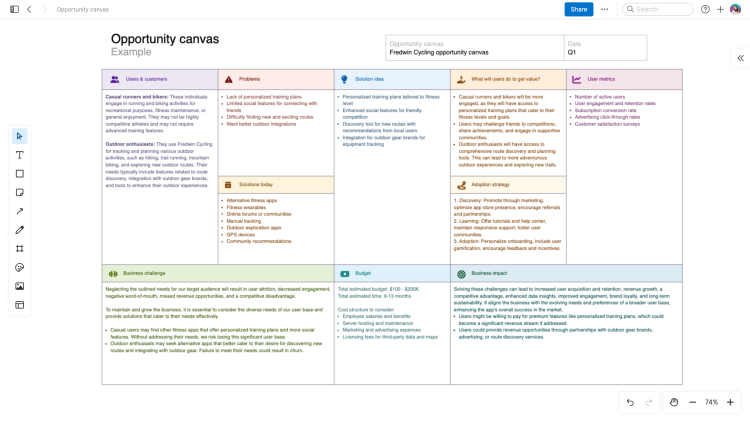
Expert templates to streamline your product discovery work
12 templates for better product discovery — from sparking ideas to evaluating opportunities
What do your customers actually need? This is a fundamental question every product manager should ask — not just once, but constantly. But getting solid answers takes more than a survey or a few calls. It requires digging past surface-level feedback to find patterns that truly matter.
Real product discovery is how you connect what you hear to what you build.
We talk to a lot of product teams that are doing the right things: shipping regularly, meeting with customers, and gathering feedback. But when we ask how that discovery work informs product decisions, the answers are often vague or disconnected. Research happens, but the insights rarely make their way into the actual planning.
At Aha! we break product development into 10 stages, from setting strategy to measuring success. (They are not linear steps, but an ongoing cycle. Teams often move through multiple stages at once.) Discovery is stage two. But in practice, it shows up everywhere. You should be discovering continuously — learning from customers, shaping ideas, and refining plans as you go. It all feeds into stronger decisions downstream.
Without structure, discovery work gets stuck in research mode. It never makes the leap to shaping what comes next.
This is where a bit of guidance can help. Whether you are trying to organize customer input or make sense of what you are learning, a structured approach keeps you focused. That is part of why we built a library of 100+ templates to support every stage of product development. Below are 12 that are especially useful during discovery. Try them as-is or adjust them to fit how your team works.
Here is how you might use these templates during discovery work:
1. Customer research plan
Start by clarifying your goals. What are you trying to learn or validate? Which customers will you talk to? How will you use what you find? The customer research plan template helps you align on the scope of your research and define what success looks like.

2. Brainstorming session
There are plenty of ways to use the brainstorming session template. During discovery, it can be helpful for generating ideas about which customers to interview, what topics to explore, or how to frame your research approach. Capture input from the team and narrow in on the most promising directions.
3. Concept map
Use the concept map template when you need to make sense of a broad topic or messy problem. Sketch out key themes, relationships between ideas, and areas that warrant deeper exploration during interviews or early experiments.
4. Problem framing
Use the problem framing template to revisit the challenge you are trying to understand. It helps you examine the issue from different angles — what is happening, why it matters, and how it affects customers — so you can uncover what you really need to solve.
5. Customer empathy map
Empathy maps are great tools for stepping into your customers' mindset. Use this customer empathy map template to think through what customers are thinking, feeling, and doing — to find where they might run into friction. It can guide both interview prep and how you interpret feedback.

6. Customer journey map
Zoom out and look at the full customer experience. The customer journey map template helps you chart each customer touchpoint and highlight moments that influence how users perceive your product or company. It can shape where you focus your discovery efforts and what questions you want to explore.
7. Customer interview
Good interviews start with good prep. Use this customer interview template to outline interview topics, shape your questions, and capture takeaways from each conversation.
8. 5 Whys
When you hear the same problem from multiple customers, it is worth pausing to ask why. The 5 Whys template gives you a simple way to trace issues back to their source and reveal what otherwise might go unquestioned.
9. Opportunity canvas
Once you gather enough input, you need a way to evaluate which ideas are worth pursuing. Use the opportunity canvas template to sketch out the potential value, risks, and effort involved in solving a specific customer problem.

10. Opportunity solution tree
Not every piece of feedback leads to a clear next step. The opportunity solution tree template, inspired by the work of Teresa Torres, helps you break down big opportunities and explore multiple solution paths. It is especially useful when deciding where to invest first.
11. Proof of concept
Ready to test an idea? Use the proof of concept template to define what you are building, how it works, and how you will measure success. It keeps early experiments focused and grounded.
12. Jobs to be done
Discovery work often surfaces a long list of requests. But underneath those are the real goals customers are trying to achieve. The jobs to be done template helps you identify those deeper needs — so you can prioritize solutions that will deliver the most value.
These templates are one way to jump-start discovery efforts. Use them to spark better thinking and move from customer input to meaningful action.
All of these templates (and more) are available in Aha! Roadmaps. You will also find templates for scoping business models, researching competitors, laying out early product roadmaps, and so much more.
If you are looking for a purpose-built tool to manage discovery and customer interviews, we just launched Aha! Discovery. It gives you a central place to plan research, bring structure to conversations, and pull meaningful insights into your product planning.
Aha! Discovery is built for teams that want a better way to capture real conversations and connect them to the roadmap.
The value of discovery is not in the volume of research you have — it is what you do with it. When you build learning into the core of how you work, you can make faster, clearer decisions. And you give the best ideas a real chance to win.
Aha! Discovery is the new way to manage customer interviews. Start a trial — free for 30 days.




